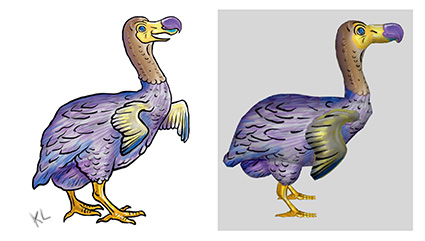
The dodo (Raphus cucullatus) has been the object of curiosity and ridicule ever since its discovery in Mauritius by Europeans around the end of the 16th century. Regretfully, it was brought to extinction in the late 17th century by island settlers, but lived on through establishing its own particular mythical status.
It was during September 1865 that the first dodo fossilised bones were discovered in the Mare aux Songes marsh, Mauritius. Not only was this important to the advancement of Victorian natural history, but the discoverer realised it would also be equally important in advancing his finances. The abundance of bird skeletons found was downplayed as it would help keep the market price inflated when sold to collectors and museum collections.
The poor dodo not only became an emblem of the carelessness that leads to the extinction of a living species, but also a powerful symbol fuelling our collective imaginations ever since. Perhaps, the most celebrated dodo in fiction comes from the pages of Alice’s Adventures in Wonderland by Lewis Carroll, which was wonderfully illustrated by John Tenniel.
The dodo continues to be drawn upon in literary works up to the present day. It is one of many rare and strange creatures encountered in Veronica Cossanteli’s delightful children’s novel, The Extincts (Extincts webpage at The Chicken House). I created a black and white dodo colouring sheet for Veronica a while ago, but couldn’t resist colouring it up myself (as seen above).
Recommended further reading on the controversy of the discovery of dodo fossils in the 19th century:
J.P. Hume, A.S. Cheke and A. McOran-Campbell 2009. How Owen ‘stole’ the Dodo: Academic rivalry and disputed rights to a newly-discovered subfossil deposit in nineteenth century Mauritius. Historical Biology, vol. 21, Nos. 1–2, pp. 33–49. Pdf version

